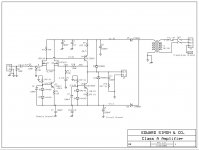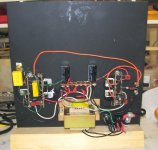What is out there for a DIY design reasonably worked out in the lower power range. Say 35 watts or so. I mean really good practical AB type. Not some monster class A. (sorry Mr. Pass), or some chip-amp like came in my $100 AVR, but a darn decent amp. Modern op-amps are so good, one could use them for the voltage gain and splitter, single outputs for this power. Regulated power for the gain stage. You get the idea. Can anyone best my little Creek or Rotels? I see rip-off boards for things like Naim's out of China. I guess they should be both mad and flattered. Of course I see stolen designs for amps that should have died long ago too.
I have a nice little chassis that currently holds an Aimor integrated amp. As I am not impressed with it, I though I might recycle the nice case, power transformer heat sinks etc, build in my crossovers and the amp for the tweeters.
I have a nice little chassis that currently holds an Aimor integrated amp. As I am not impressed with it, I though I might recycle the nice case, power transformer heat sinks etc, build in my crossovers and the amp for the tweeters.
Find the ASKA 55 (use search) and dial the PS down a bit. Or try one of the DX variants that work on lower voltages. Single output pair is probably all you need
Member
Joined 2009
Paid Member
'really clean' isn't what I think of when I listen to my AKSA clone - of course that could be my fault but AKSA was designed to be more than 'really clean'. For 'really clean' I'd look to something more along the lines of the DX precision or DX HRII... Greg's Web Site
take a look at
Update My Dynaco
I sell LM3886 modules for retro-fit into Dynaco Stereo 120's. Now, you might complain that LM3886 is a gain-clone, but my opinion is that transistors is transistors, and you can make a lot of difference if your caps and resistors are the good stuff, and the layout is clean.
You'd only be shy the regulated power supply...I've designed and prototyped one that works just fine, but I'm awaiting the final PCB. I've been shipping the amp PCB's for about 1 year now. The super heat sinks make a nice clean mounting system.
Apologies for the "shameless commerce" aspects of this post, but you might find other useful information on the web site, for example:
http://www.updatemydynaco.com/documents/GroundingProblemsRev1p4.pdf
Update My Dynaco
I sell LM3886 modules for retro-fit into Dynaco Stereo 120's. Now, you might complain that LM3886 is a gain-clone, but my opinion is that transistors is transistors, and you can make a lot of difference if your caps and resistors are the good stuff, and the layout is clean.
You'd only be shy the regulated power supply...I've designed and prototyped one that works just fine, but I'm awaiting the final PCB. I've been shipping the amp PCB's for about 1 year now. The super heat sinks make a nice clean mounting system.
Apologies for the "shameless commerce" aspects of this post, but you might find other useful information on the web site, for example:
http://www.updatemydynaco.com/documents/GroundingProblemsRev1p4.pdf
Much thanks. Gives me ideas.
The DX looks quite intriguing. I might "borrow" with all due credit a feature or two and modify my DH 120. Or, if I have enough transformer laying around and just build one. It looks to be very much what I had in mind. I need to check the transformer in a Yamaha receiver I am about to junk. Dirty volume control ( sealed) and let's face it, Yamahamer receivers were always a bit too crisp sounding. Instead of fixing it for my Nephew, I think I'll get him into an older Denon.
I know power modules are even being used by Roland, but I don't know, it is just tough for me to accept it. It took long enough for me to realize the modern op amps are darn near fantastic. I have no doubt the 3886 is are a huge improvement over the original ST 120. I would hope we have learned something in 40 or 50 years! In a module, they can, don't know if the do, add a lot of compensation circuits and make things very nice. They can match parts we can't on the outside. Maybe. It will take come convincing. This is a long term think before I build. I have several speakers to get done.
The DX looks quite intriguing. I might "borrow" with all due credit a feature or two and modify my DH 120. Or, if I have enough transformer laying around and just build one. It looks to be very much what I had in mind. I need to check the transformer in a Yamaha receiver I am about to junk. Dirty volume control ( sealed) and let's face it, Yamahamer receivers were always a bit too crisp sounding. Instead of fixing it for my Nephew, I think I'll get him into an older Denon.
I know power modules are even being used by Roland, but I don't know, it is just tough for me to accept it. It took long enough for me to realize the modern op amps are darn near fantastic. I have no doubt the 3886 is are a huge improvement over the original ST 120. I would hope we have learned something in 40 or 50 years! In a module, they can, don't know if the do, add a lot of compensation circuits and make things very nice. They can match parts we can't on the outside. Maybe. It will take come convincing. This is a long term think before I build. I have several speakers to get done.
I'd suggest Self (latest edition) and Cordell's books on amp design for hints on DH 120 mods likely leading to lower measured distortion
but in addtion to topology choices I see rather poor PCB, poor wiring and ps parts location suggestions in the Hafler kit manual
"fixing up" a chip amp with added high quality modern op amp feedback loop is attractive but the compensation requirements for worst case chip amp specs limits the added loop gain rather severly by 20 kHz, the nested loops may give worse clipping recovery too without extra nonlinear compensation "anti-windup" circuitry
but in addtion to topology choices I see rather poor PCB, poor wiring and ps parts location suggestions in the Hafler kit manual
"fixing up" a chip amp with added high quality modern op amp feedback loop is attractive but the compensation requirements for worst case chip amp specs limits the added loop gain rather severly by 20 kHz, the nested loops may give worse clipping recovery too without extra nonlinear compensation "anti-windup" circuitry
jcx,
Cordell's book was just recommended, I will add Self.
No question, the mechanical layout of the DH 120 is not great. I have new electrolytic caps on order with far lower esr as I have no doubt they are all dry and leaking in a 30 year old amp. Just to see for myself, a hexfred rectifier. I already ditched the Dynaquad and bridging, replaced the rear pots with an Alps and am making a list of a few other tricks. I will do a full tri-star for power and ground and I am considering raising DCC off the chassis. I am not planning on changing the basic design. Maybe replace the dropping resistors feeding the gain stage with regulators.
Cordell's book was just recommended, I will add Self.
No question, the mechanical layout of the DH 120 is not great. I have new electrolytic caps on order with far lower esr as I have no doubt they are all dry and leaking in a 30 year old amp. Just to see for myself, a hexfred rectifier. I already ditched the Dynaquad and bridging, replaced the rear pots with an Alps and am making a list of a few other tricks. I will do a full tri-star for power and ground and I am considering raising DCC off the chassis. I am not planning on changing the basic design. Maybe replace the dropping resistors feeding the gain stage with regulators.
- Status
- Not open for further replies.
- Home
- Amplifiers
- Solid State
- Really clean medium power amp wanted

